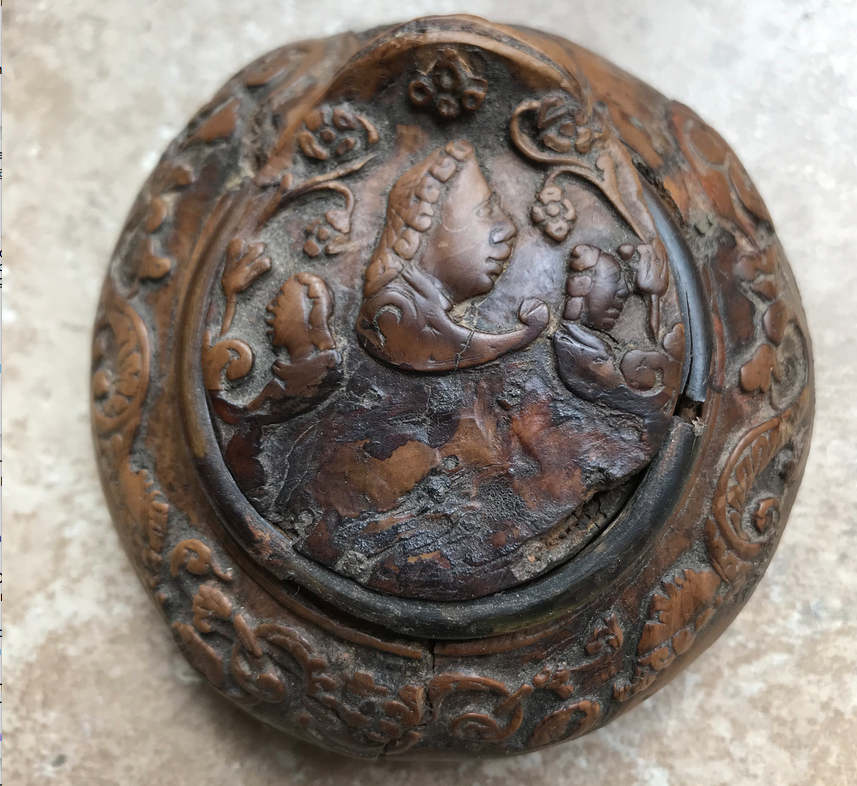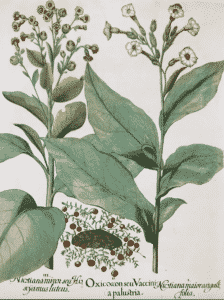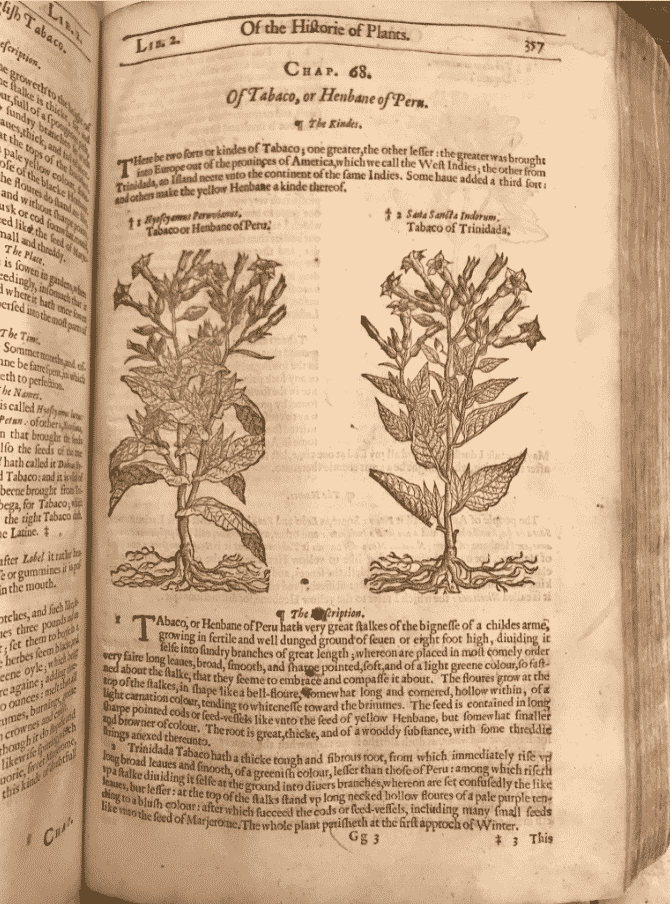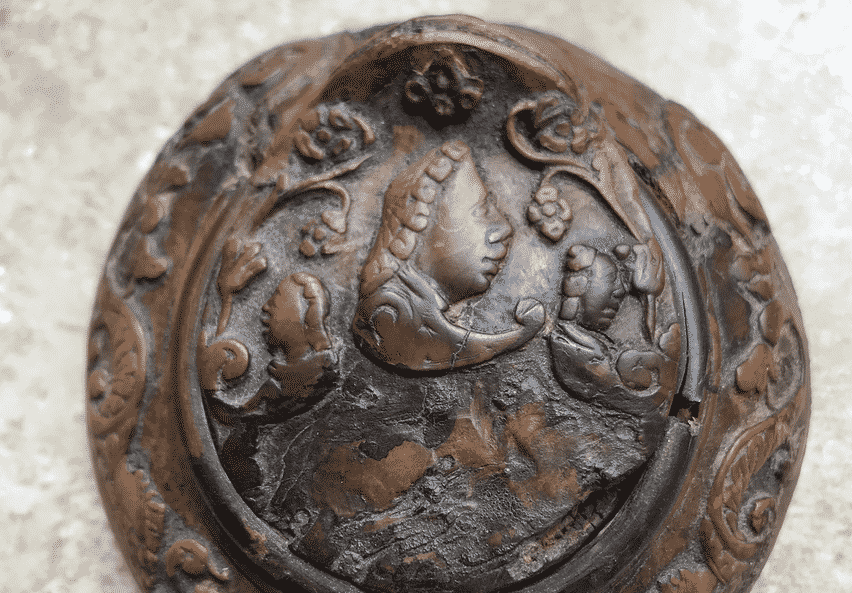
This is a guest post from the wonderful Brigitte Webster, founder and owner of the amazing Tudor & 17th Century Experience, an exquisite living history retreat, appreciation and seminar center in East Hertfordshire / England. Brigitte and her team provide guests with the opportunity to step back in time and fully immerse themselves in the age of the Tudors or Stuarts – by living, dressing, sleeping, eating & drinking, playing and working like someone 500 or 400 years ago. It is an experience I will soon taste myself, and this post is a lovely example of the attention to detail that Brigitte brings to everything she does….Hope you enjoy!
***
No other natural material from the New World altered European society on so many registers. This ‘holy plant’ (herbal sancta) was hailed and praised in the Christian world because of its role in the religious rituals and medicinal practices of the so-called heathens of the Americas.
The first record of tobacco was made by Christopher Columbus’s sailors on his expedition of 1492, when they observed Cubans and Haitians burning the leaves and inhaling the smoke through a ‘tobacco”, a device shaped like a catapult with two arms that fitted the nostrils.
The tobacco seed reached Europe around 1520 but it was evidently not cultivated to any extent to have been recorded.

One of the earliest chroniclers of New World plants was the Spanish physician Nicolas Monardes and his ‘Dos Libros‘ was published in Seville in 1569. He also devoted considerable space to tobacco in “Primera y segued tercara parties de la history medicinal” in which he listed the medicinal virtues of tobacco in the treatment of headaches, chest complaints and worms but also provided a detailed description of the narcotic effects of smoking or chewing tobacco.
In the English court, however, people preferred to smoke the dried leaves, following the example of Sir Walter Raleigh. There is evidence, that tobacco was also smoked in Germany from the beginning of the 17th century. In 1624 Pope Urban VIII felt that it was necessary to publish a decree of excommunication against all those who took snuff in church !
Spanish merchants introduced the plant to Europe some time in the 1540s, and the first illustration of the wild tobacco plant from North or Central America appeared in Rembert Dodoes’s herbal of 1554, which identified it as ‘henbane’. The German botanist Leonhart Fuchs named the plant Nicotiana in honour of Jean Nicot (1530-1600), the French Ambassador to Portugal, who around the year 1559 sent tobacco seeds to the French Queen and other members of the court.
In 1586, after his return with Francis Drake from a year with the Roanoke Island colony in Virginia, English explorer and mathematician Thomas Harriot produced a pamphlet “A Brief and True Report of the New Found Land of Virginia” ( 1589) , with drawings by artist John White, to advocate the idea of an English empire overseas and to encourage fresh settlers and investors. He mentioned ‘operauk‘ (potatoes) and ‘uppowa‘ (tobacco) which he recommended smoking for the purging of ‘superfluous phlegm‘. He also described the cultivation and smoking of tobacco by the native Indians and both Harriot and Sir Walter Raleigh (on whose behalf Harriot established the colony on Roanoke Island) are thus often credited with the introduction of tobacco smoking in England but it was John Frampton with the publication of “Joyfull news out of the new-founde world’, a translation of Nicolas Monardes’s work, in 1577 who really deserves that credit.

“La Maison Rustique“, first published in 1554 by physician Charles Estienne and translated into English by Richard Surflet in 1600, offers help on all kind of herbs including tobacco. The section on tobacco must have proved useful to the colonists, for John Rolfe (Later Husband of Pocahontas, daughter of Powhatan) had begun to plant seeds of the sweeter kind ( Nicotiana tabacum) , imported from Trinidad and Southern America. John Rolfe created colonial England’s first viable crop for export and Virginia’s first shipment of tobacco arrived in England in 1614.
Medicinally and spiritually tobacco was heralded throughout Europe earning its name “holy plant” (Edmund Spencer) and “divine” (Ben Johnson in his plays 1598 and 1599 & Jose de Acosta 1590 – ‘Tobacco is devine because it cures but also because priests deliver it’)
Tobacco from Jamestown (established in 1607) quickly became the principal export from the colony and James I who loathed the smoking of tobacco, partly recognising its toxic effects, published his “ Counterblaste to Tobacco” condemning the ‘manifold abuses of the this vile custom’.
The royal disapproval did not remain for long and James’ need for money overcame his objections and heavy customs duties were imposed upon imported tobacco, while the Virginian trade was protected by a ban on cultivation in England.
During the 1590s the English either imported Spanish tobacco or directly purchased it from the Natives.
In 1612, the year Rolfe brought tobacco to Virginia, no South American tobacco crops were available, because the Spanish had forbidden the Natives from cultivating it in Trinidad, were 60% of English consumed tobacco came from.
In 1619 James issued a proclamation on the grounds that ‘Inland plantation‘ had allowed tobacco to ‘become promiscuous and begun to be taken in every mean village even among the basest people‘. The king further claimed, that he had been advised by experts that the English variety was cruder and more poisonous than the Virginian !
By the 1620s Englishmen needed to invest £7000 annually for a tobacco import licence and no tobacco was to be grown in England other than in physic gardens.
That was not good news for the botanist John Goodyer, who had cultivated the plant in his garden at Droxford in Hampshire. He had acquired his seeds of two kinds of tobacco from the Grosvenor of Winchester Gaol’ who …….. ‘intended to plante greate store thereof, and was hindered of his purpose by a proclamation settle forth by Authoritie.’
James I’s ‘devil’s weed’ earned him a £16000 annually on customs duties. However, there was no lack of consumers and the existence of 7000 tobacco shops in London alone attests tobacco’s popularity. After the first shipment from Virginia in 1614, an astounding 1.5 million pounds of tobacco was shipped annually !
By the 1620s, tobacco dominated English foreign trade, taking over from the lucrative cod fishery off Newfoundland.
This Indian herb, in fact, became money in itself. Tobacco became the standard in barter, the measure of values and the alternative basis of currency. Taverns accepted it as legal tender and it served to pay taxes, fines and the wages of solders. Women were sent to Virginia as wives in exchange for “120 lb. waight of the best leaf Tobacco for each of them‘. In 1672 Charles II ordered the minting of tobacco coins which served as money and advertisement.
However, the powerful tobacco market also brought painful misery to the planters who preferred to plant tobacco over necessary food crops due to much better prices payed. Because of the dietary neglect, the colonists continued to rely on the Indians for sustenance.

John Gerard in his herbal of 1597, noted that tobacco was easy to cultivate and ‘ being now planted in the gardens of Europe, it prospereth very well and commeth from seede in one year to bear both flowers and seede……Tobacco must be sown in the most fruitfull grounde that may be founde, carelessly cast abroade in the sowing, without taking it into the ground or any such pain or industrie taken, as is requisite in the sowing of other seedes.’
He also lists the names under which he knew the plant such as petun (native), sacra herbs or sancta herba (Lobel and Pena), hyoscyamus peruvianus or henbane of Peru, tabacum (Niccolaus Manardus) as well as nicotiana (Leonhart Fuchs). According to the teachings of Galen, he describes tobacco as hot and dry in the second degree (Rembert Dodoens calls it ‘cold’ – so not much agreement going on !) and mentions its power to cleanse away filthy humours by purging the stool. Interestingly though he also goes on to say, that ‘those leaves do palliate or ease for a time, but never perform any cure absolutely, for although they empty the body of humours, yet the cause of the grief cannot be so taken away’.
The Native American custom of smoking tobacco, that became English habit changed the inner body of the smoker, because tobacco transforms the humours that were believed to regulate the body in early modern Europe.
In 1649, Nicolas Culpepper records the following on tobacco in his ‘Complete Herbal’ : Tobacco, and in reciting the virtues of this herb, I will follow Cl(a)usius, that none should think I do it without an Author. It is hot and dry in second degree, and of a cleansing nature, the leaves warmed and applied to the head are excellent good in inveterate head aches and megrims… Taken in a pipe it hath almost as many virtues, it easeth weariness, takes away the sense of hunger and thirst, provokes to stool …. and a man might fill a whol volume with the virtues of it “
‘King Tobacco‘ or “Holy Plant” found its way into multiple literary genres : Masque, drama, poetry and ballads – from private herbal gardens of physicians to the public tobacco shops of London streets.
Tobacco appears frequently in literature of the early English Renaissance and it is a mystery why it is not once mentioned in any of Shakespeare’s plays.
The dramas of Ben Jonson, particularly Every Man in His Humour (1598) and Every Man out of His Humour (1599) depict tobacco on stage in virtually every scene but tobacco becomes a fetish, once removed from its sacred use and turning into a ‘roguish’ disease, an excessive consumption for show, which started to plague London society in the 1590s.
In the elite poetry of Edmund Spencer’s The Faerie Queene (1590), the term ‘divine‘ is repeatedly linked to tobacco. Take this example from American faery : Poetry (The Faerie Queene, 3.5.32-33):
Into the woods thenceforth in hast she went,
To seek for hearbes, that mote him remedy;
For she of hearbes had great intendment,
Taught of the Nymphe, which from her infancy
Her nourced had in trew Nobility:
There, whether it diuine Tobacco were,
Or Panachea, or Polygony,
She found, and brought it to her patient deare
who al this while lay bleeding out his hart-bloud neare.
The divine is also linked to tobacco in Beaumont’s “The White Reader” in “The Metamorphosis of Tobacco” 1602 :
Take up these lines Tabacco-like unto thy braine
And that divinely toucht, puffe out the smoke again.
With such a power of negative and positive transformation, this amazing plant can be viewed as the creator and destroyer of the Golden Age.
Source and list of further reading : The Making of the English Gardener (Margaret Willes) 2011; A Garden of Pleasant Flowers (John Parkinson) 1629; Libri Picturati A18-30, Jagiellonian Library, Krakow, Poland; The Herbal ( John Gerard ) 1597, 1633; Florilegium ( Basilius Besler) 1613; The Complete Herbal ( Nicholas Culpepper) 1649; Death in the Garden (Michael Brown) 2018; Sacred Seeds: New World Plants in Early English Literature (Edward McLean Test) 2019
***
If you like my posts, you’ll love my books! The Path to Somerset came out on August 24 – have you ordered your copy yet? Click on the photo to be taken to Amazon.Com:
(What? You haven’t read Jane the Quene yet? Here are some easy links to Amazon.Com, Amazon.Co.UK and Amazon.Com.Au!)


Be First to Comment